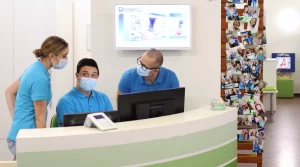The integration of software in orthodontic telehealth is transforming patient care. These platforms facilitate efficient communication, allowing orthodontists to provide real-time feedback and support. With features like secure messaging and analytics tools, they enhance patient engagement and treatment adherence. However, challenges remain in optimizing these technologies for diverse patient needs. Understanding how the right software can address these challenges is vital for advancing telehealth outcomes in orthodontics. What comes next may redefine patient experiences.
Key Takeaways
- Effective telehealth software enhances communication, fostering stronger patient-provider relationships and boosting engagement through real-time messaging features.
- User-friendly interfaces in telehealth software ensure accessibility for diverse patient demographics, improving overall patient experience and satisfaction.
- Advanced analytics tools in software track treatment progress, enabling informed decision-making and personalized care for each patient.
- Streamlined appointment scheduling and secure messaging reduce appointment cancellations, leading to increased efficiency in orthodontic practices.
- Integrating predictive analytics and AI in telehealth software can tailor interventions and improve diagnostic processes, enhancing treatment outcomes.
The Rise of Telehealth in Orthodontics
As advancements in technology continue to reshape healthcare, the rise of telehealth in orthodontics has emerged as a transformative trend. This innovative approach allows patients to engage with their orthodontic providers remotely, utilizing digital platforms for consultations and treatment monitoring. By integrating advanced imaging technology and secure communication tools, orthodontists can assess treatment progress without requiring frequent in-office visits. This not only enhances convenience for patients but also fosters a sense of community, as they remain connected to their providers throughout the process. Telehealth outcomes in orthodontics have shown promising improvements in patient satisfaction and treatment adherence, reflecting a growing acceptance of virtual care. Ultimately, this shift toward telehealth signifies a more inclusive and accessible orthodontic experience for all.
Key Challenges Impacting Telehealth Outcomes in Orthodontics
While the integration of telehealth has considerably enhanced patient engagement and treatment monitoring in orthodontics, several key challenges remain that can impact telehealth outcomes in orthodontics. These challenges include:
- Technical Limitations: Not all patients have access to reliable internet or devices, which can hinder effective communication and consultation.
- Data Security Concerns: The sensitivity of patient information necessitates robust security measures, yet some practices may lack the necessary infrastructure to protect this data adequately.
- Regulatory Compliance: Maneuvering the complex landscape of telehealth regulations can be intimidating for orthodontic practices, potentially leading to inconsistencies in service delivery.
Addressing these challenges is essential to optimizing telehealth outcomes and ensuring that patients feel supported and connected throughout their treatment journey.
The Role of Software in Enhancing Telehealth Experiences
Effective software solutions play an essential role in enhancing telehealth experiences in orthodontics by streamlining communication and improving patient engagement. These platforms facilitate real-time interactions between orthodontists and patients, enabling immediate feedback and personalized care. Features such as appointment scheduling, secure messaging, and virtual consultations foster a sense of belonging for patients, making them feel valued and connected. Advanced analytics tools also track treatment progress, allowing practitioners to make informed decisions based on thorough data. Additionally, user-friendly interfaces guarantee accessibility, catering to diverse patient demographics. By leveraging these technological innovations, orthodontic practices can greatly elevate telehealth outcomes in orthodontics, ultimately leading to improved patient satisfaction and healthier smiles.

Case Studies: Successful Implementation of Telehealth Software
Telehealth software has transformed orthodontic practices, evidenced by several successful case studies that highlight its impact on patient outcomes and operational efficiency. These implementations showcase the benefits of integrating technology into patient care:
- Increased Accessibility: A practice reported a 40% rise in patient consultations, enabling individuals in remote areas to receive expert orthodontic guidance.
- Enhanced Communication: Another case revealed that real-time messaging features led to a 30% improvement in patient engagement, allowing for immediate resolution of concerns.
- Streamlined Workflow: One clinic’s shift to telehealth resulted in a 25% reduction in appointment cancellations, optimizing scheduling and resource allocation.
These examples illustrate how telehealth outcomes in orthodontics can be greatly improved through the strategic use of software, fostering a sense of community and support among patients and providers alike.
Future Trends in Telehealth Outcomes for Orthodontics
As advancements in technology continue to evolve, the future of telehealth outcomes in orthodontics appears promising and multifaceted. Enhanced software solutions are anticipated to facilitate real-time monitoring, improving patient engagement and satisfaction. Predictive analytics will likely play a significant role in anticipating treatment responses, allowing orthodontists to tailor interventions more effectively. In addition, the integration of artificial intelligence is expected to streamline diagnostic processes, enabling precise treatment planning. Virtual reality could provide immersive educational experiences, fostering a deeper understanding of orthodontic procedures among patients. As Results of telehealth in orthodontics, advance, a more inclusive approach will emerge, ensuring that individuals from diverse backgrounds feel connected and supported throughout their treatment journey. This evolution highlights a commitment to patient-centered care in a digital age.
Frequently Asked Questions
What Are the Costs Associated With Telehealth Software for Orthodontics?
The costs associated with telehealth software for orthodontics can vary considerably, encompassing subscription fees, hardware investments, training expenses, and ongoing technical support, ultimately impacting accessibility and quality of care for patients seeking orthodontic treatment.
How Do Patient Demographics Affect Telehealth Outcomes in Orthodontics?
Patient demographics greatly influence telehealth outcomes in orthodontics. Factors such as age, technological proficiency, and socioeconomic status impact engagement, accessibility, and satisfaction, ultimately shaping the effectiveness of virtual consultations and treatment adherence within diverse patient populations.
What Security Measures Are in Place for Telehealth Software Usage?
Telehealth software employs various security measures, including end-to-end encryption, secure user authentication, and regular software updates. These protocols guarantee patient data remains confidential, fostering trust and enhancing overall telehealth outcomes in orthodontics.
Can Telehealth Be Used for Emergency Orthodontic Consultations?
Telehealth can effectively facilitate emergency orthodontic consultations, enabling patients to receive timely advice and guidance. This approach enhances accessibility, ensuring that individuals feel supported and informed during urgent situations, fostering a sense of community and care.
How Is Patient Data Managed in Telehealth Orthodontic Practices?
In telehealth orthodontic practices, patient data is meticulously managed through secure software platforms, ensuring confidentiality and accessibility. These systems facilitate streamlined communication, enhance patient engagement, and improve overall telehealth outcomes in orthodontics by providing real-time data insights.
Conclusion
To summarize, the strategic implementation of advanced telehealth software is pivotal in transforming orthodontic care. By enhancing communication, streamlining workflows, and providing real-time analytics, these platforms greatly improve patient engagement and treatment adherence. As the orthodontic landscape continues to evolve, embracing innovative technologies will not only address existing challenges but also pave the way for more personalized, accessible, and effective care. Ultimately, the right software is essential for fostering positive patient outcomes in telehealth orthodontics.
You May Also Like To Read:


